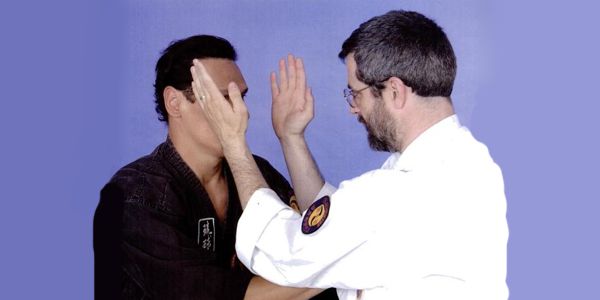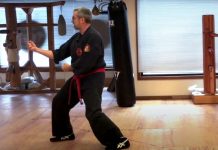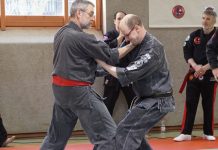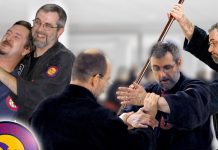When traditional karate practitioners are introduced to pressure point fighting and shown how it unlocks the secrets of kata and other aspects of classical training, several reactions may be observed. Some people remark, “Everything I’ve learned finally makes sense.” Others exclaim: “How come I was never taught this before? I’ve been wasting my time for the past 20 years.” Still others respond with, “Oh, my master knows that stuff,”—as if having a teacher who’s familiar with it means they don’t need to learn it for themselves.
An even more puzzling response often comes from traditionalists: “That’s very interesting and makes perfect sense, but it’s not part of my style.” It’s puzzling because learning about pressure points is equivalent to discovering what a style is all about, yet somehow they believe any body of knowledge the founder isn’t known to have taught must be illegitimate.
Some of those who offer that not-my-style excuse are members of the isshin-ryu karate community. Their reasoning seems to be that if founder Tatsuo Shimabuku (also spelled Shimabukuro) never taught pressure points, they don’t belong in the style. And by extension, if one interprets the style using pressure-point theory, he’s no longer practicing real isshin-ryu.
There are two ways to respond to that attitude. One is to argue that any style is just a tool to serve the practitioner and the practitioner is not a servant of the style. But all people have a desire to serve some great revelation, to adhere and submit to something that is unquestionably true and inherently authoritative. That’s why there are ideological zealots, religious fundamentalists and martial arts traditionalists.
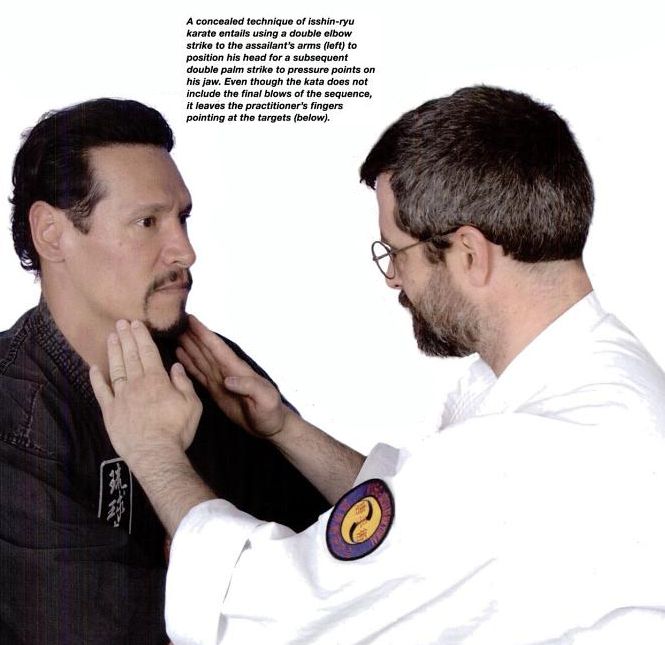
That being the case, it’s probably better to take a different approach and pose three simple questions: Did Shimabuku know pressure point methods? Did he include pressure point theory in his style? And did he drop enough clues for his successors to pick up the practice?
The answer to each one appears to be yes.
Question 1
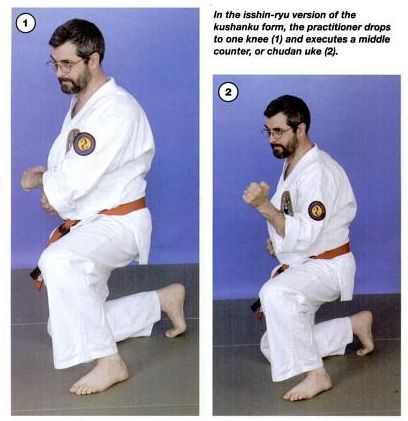 It’s almost impossible to imagine that Shimabuku—a student of Chotoku Kyan (shorin-ryu), Chojun Miyagi (founder of goju-ryu) and Choki Motobu (founder of motoburyu tode-jitsu)—never learned about pressure points. It’s well-known that Motobu used and taught pressure point techniques, and many claim they affected his approach to kata. (For example, according to Mark Bishop, his naihanchi form differed from other versions in that “the techniques consisted of throws using pressure on vital points.” Shimabuku learned the kata from Motobu, so he must have picked up at least some of the pressure- point information that was so central to Motobu’s method.
It’s almost impossible to imagine that Shimabuku—a student of Chotoku Kyan (shorin-ryu), Chojun Miyagi (founder of goju-ryu) and Choki Motobu (founder of motoburyu tode-jitsu)—never learned about pressure points. It’s well-known that Motobu used and taught pressure point techniques, and many claim they affected his approach to kata. (For example, according to Mark Bishop, his naihanchi form differed from other versions in that “the techniques consisted of throws using pressure on vital points.” Shimabuku learned the kata from Motobu, so he must have picked up at least some of the pressure- point information that was so central to Motobu’s method.
Every isshin-ryu practitioner is familiar with the Code of Isshin-Ryu. It’s a set of eight aphorisms said to describe the underlying principles of the style. Many practitioners assume Shimabuku wrote it, since he often presented his earliest American students with a handwritten silk containing the message in Japanese characters along with an unusual English translation. However, the code of Isshin-Ryu is actually the Eight Precepts of Kempo as set forth in a martial arts text titled Bubishi. And if Shimabuku was familiar with it, he clearly knew pressure-point methods.
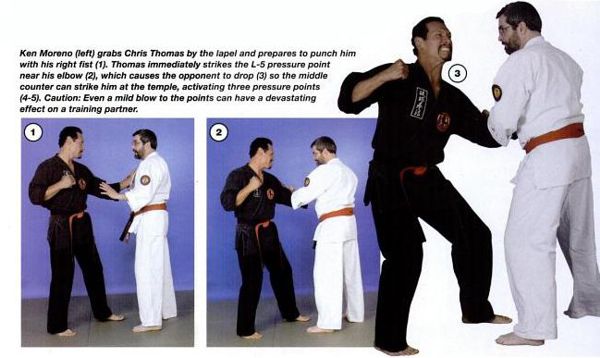 Bubishi was a valued document that trusted students hand-copied from their teacher’s edition. Nevertheless, much of the text was made available to the public in a 1934 book titled Kobo Jizai Karate Kempo Seipai no Kenkyu, by Kenwa Mabuni. Mabuni said he’d personally copied his version from that of his teacher, Anko Itosu. But it’s also generally believed that Mabuni’s other primary teacher, Kanryo Higaonna, possessed and cherished the document. Higaonna’s student, Chojun Miyagi, derived the name “goju-ryu” from Bubishi and is said to have considered it the “bible of the civil fighting arts,” according to Patrick McCarthy. Since Shimabuku trained with Miyagi, he could have had direct access to his teacher’s copy, as well as to Mabuni’s book.
Bubishi was a valued document that trusted students hand-copied from their teacher’s edition. Nevertheless, much of the text was made available to the public in a 1934 book titled Kobo Jizai Karate Kempo Seipai no Kenkyu, by Kenwa Mabuni. Mabuni said he’d personally copied his version from that of his teacher, Anko Itosu. But it’s also generally believed that Mabuni’s other primary teacher, Kanryo Higaonna, possessed and cherished the document. Higaonna’s student, Chojun Miyagi, derived the name “goju-ryu” from Bubishi and is said to have considered it the “bible of the civil fighting arts,” according to Patrick McCarthy. Since Shimabuku trained with Miyagi, he could have had direct access to his teacher’s copy, as well as to Mabuni’s book.
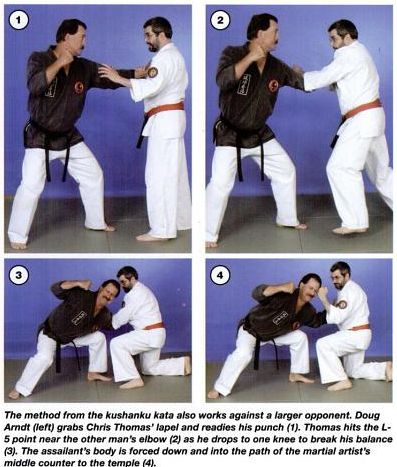
Bubishi contains instructions on pressure point methods, including information about seven extremely dangerous points, time-of-day correspondences, combat techniques and combinations.
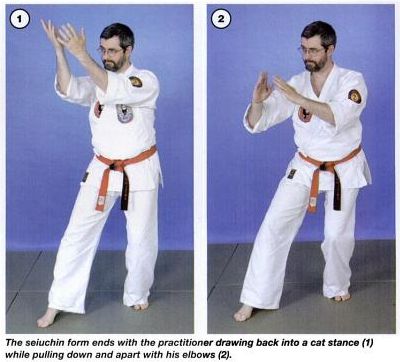
The fact that the book shows combinations and not just individual points is noteworthy. Most martial artists know at least two points—often they are the one located under the ear and the one near the temple—but that doesn’t mean they know pressure point fighting. Genuine pressure point fighting is based on the application of pressure in combinations. That Bubishi contains such information means that not only was Shimabuku aware of the methods, but he also knew at least two key concepts: the use of points in combination and the principle of the diurnal cycle (time of day).
Question 2
Having established that Shimabuku knew pressure point methods, the next question is, Did he include those methods in isshin-ryu karate? The answer can be found in the kushanku kata.
According to Harry G. Smith, Shimabuku spent time in the Philippines during World War II teaching Japanese troops how to fight the Americans. And he certainly was a good choice for the job because he’d been a student of Kyan’s.
Kyan was very small by Okinawan standards, so he’d developed his karate around the needs of a smaller man fighting a larger one. Shimabuku was average for an Okinawan but tiny compared to most Americans. As a result of Kyan’s teaching, Shimabuku was in familiar territory when it came to the size problem. In kushanku, in particular, we can see one of his solutions.
The kata contains several movements that involve dropping to one knee. They’re unique to Shimabuku’s interpretation of the form. In one example, repeated twice in the kata, the technique entails dropping to a kneeling posture and performing a hand movement called chudan uke, or middle counter. Many practitioners accept the common interpretation that one has dropped down to block a low kick. The reality is quite different.
When an attacker grabs the defender’s lapel with his left hand, a standard pressure-point response is to use the left hand to strike the attacker’s arm near his elbow at a pressure point called L-5/ chize. That causes the attacker’s legs to buckle.
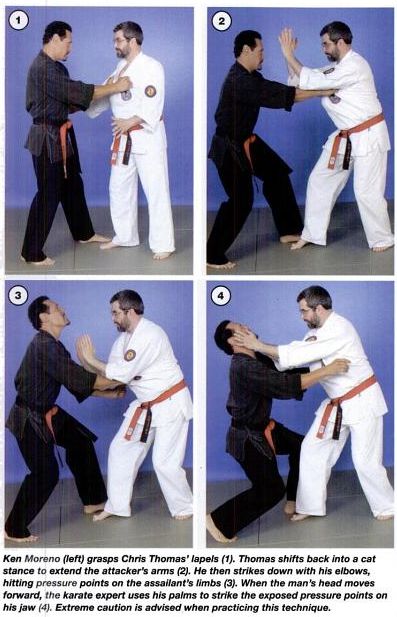
At the same time, his head drops and turns to his right, exposing his left temple. The defender then strikes it with a backfist, hitting the points GB- 1/ tongziliao, TW-23/ sizhukong and taiyang. (They are in close proximity and are struck simultaneously with a single blow.) The defender’s physical movement is chudan uke, and the attacker’s response exactly matches the defender’s technique.
However, when the attacker is much larger, the defender must strike through the attacker’s L-5 point by dropping into a kneeling stance. That brings the attacker down almost without fail, and the follow-up to the temple points finishes the encounter. Those are precisely the movements from kushanku.
It’s important to emphasize one thing: Shimabuku modified the kushanku kata. When his modification is explained using pressure-point theory, the result is an application that works against an attack by a larger opponent. The opponent’s physical reactions to the pressure-point technique exactly fit the movements of the Shimabuku-modified kata. So we have kata performance matching pressure point theory matching the attacker’s physical response in a realistic selfdefense scenario. It’s too tidy to be mere coincidence. Shimabuku must have had it in mind, and that means the art he developed is intended to include pressure-point methods.
Question 3
Although we have now arrived at our last question—Did Shimabuku reveal enough pressure-point information for his followers to be able to recognize and practice it themselves?—there’s another puzzle: Why didn’t he teach pressure-point methods in a clear and systematic way if he intended them to be a part of isshin-ryu?
It’s impossible to answer with any certainty, but there are some possibilities. For starters, when he began teaching karate to U.S. Marines, he was instructing an occupying force composed of physically larger men. It may have seemed imprudent to teach them the very methods designed to defeat them.
A second possibility has to do with the general direction of karate at the time. Since the 1930s, there had been a coordinated effort to move away from the old tode-jitsu to the modern karate-do. That transition involved a change in emphasis from functionality to spirituality. It had already occurred in other martial arts, so the karate community—eager to make a place for itself among the other great budo—pressed the view that karate was the martial art bestsuited to “fulfillment of the need for training the spirit,” as Gichin Funakoshi wrote. But despite the fact that Shimabuku adopted the new name and characters for karate-do, it appears that in all other ways he resisted the modernization of the art and retained the older, combat-oriented methods of tode-jitsu.
He experienced pressure from the rest of the karate community to conform to the modern method. In fact, it’s been reported that for a brief period during the early 1960s, he taught the modern full-twist punch but switched back to the characteristic isshin-ryu punch after a visit to the United States. After seeing many isshin-ryu students there practicing the old method, he decided there was no point in acquiescing to the general karate community.
(Note: Shimabuku was not the only instructor to experience such pressure. People tried to persuade Hohan Soken to teach the modern version of karate when he moved back to Okinawa from Argentina, and Choki Motobu was marginalized in the karate community because he persisted in practicing the old way.)
A third possibility has to do with the way in which many instructors taught the arts. It’s well-known, for example, that many traditional instructors would correct a student only once or twice. If the student continued to make the same mistake, it was never mentioned again. In many ways, that describes the approach Okinawan teachers had. They believed it was the student’s job to improve. If the teacher explained a principle or concept, the student was expected to apply it to all areas of karate and to work out the implications for himself.
Although it’s likely that all three possibilities are true to some degree, it’s the third one that seems the most plausible—namely that Shimabuku didn’t reveal much pressure-point information because, as a traditional Okinawan instructor, he expected his students to pay attention and catch on when he did reveal something. We can judge this with some confidence because he made it clear he expected his students to continue to study and develop as martial artists. Smith reported that when Shimabuku promoted him to sixth-degree black belt, “[he] told me that the rank would only be good if I trained 10 fingers’ worth—10 years—and then came back to Okinawa. I surprised him by showing up in Naha eight years later.”
Similarly, the experience of American isshin-ryu pioneer Steve Armstrong reveals the same expectation. When Shimabuku visited Armstrong in Tacoma, Washington, in 1966, he presented him with an eighth-degree diploma. However, the diploma was post-dated, and Shimabuku explained that if Armstrong continued to practice and study, when the date arrived he would genuinely have achieved that rank. Interestingly, the date on the diploma turned out to be after Shimabuku’s death.
Recorded for Posterity
During that same 1966 visit, Shimabuku was filmed while performing each kata of isshin-ryu. After that is a brief section titled Kumite, in which he demonstrates some self-defense techniques using Armstrong as his opponent. One of the techniques is particularly relevant to this discussion. It’s an application, or bunkai, for a movement from the seiuchin kata . At the conclusion, Shimabuku slides back into a cat stance, while drawing his elbows down and apart so his fingertips end up at a 45-degree angle in front of his body.
Shimabuku also demonstrates a way to defend against a two-hand lapel grab by crashing his elbows down onto the attacker’s forearms, hitting both LI-7/ wenliu points. The strike ordinarily causes the attacker’s body to drop and his head to fall forward, exposing his jaw to strikes on both S-5/ daying points. And that’s just what the film shows: Armstrong’s body drops and his head moves forward, then Shimabuku finishes with double palms, hitting each side of Armstrong’s jaw at S-5. (The palm strikes are demonstrated without meaningful contact.)
This particular combination utilizes time-of-day correspondence. The rule holds that points of vulnerability change cyclically throughout the day. However, it also reveals how energy continually flows from meridian to meridian in a specific sequence. So regardless of the time, a strike to the large-intestine meridian will always create vulnerability in the stomach meridian. The technique Shimabuku demonstrates on film exactly illustrates the operation of the diurnal cycle of ki flow through the body.
A noteworthy feature of this movement as it’s performed in seiuchin is that the kata itself shows only the elbow attack to LI-7, not the palm strikes. However, at the conclusion of the technique, in the final posture of the form, the fingers are pointing at the correct angle for the S-5 strikes— and angle of attack is a critical feature of pressure-point techniques.
If one performs the move exactly as taught in the kata against a two hand lapel grab, the attacker’s head will drop so the practitioner’s fingertips point directly at S-5 along the correct angle of attack. The last move of the kata performs only the first half of the defense, then indicates the finishing strikes by pointing at the intended targets. This type of kata movement, where part of the technique is somehow concealed, is called himitsu (secret) or hiden (secret teaching).
That Shimabuku knew this concealed application indicates that either he was shown it by his teacher, Miyagi, or that his knowledge of pressure point theory was thorough enough for him to recognize the meaning of the movement. Either way, the conclusion is inescapable: On film, Shimabuku revealed pressure-point techniques, even “secret” techniques, for Armstrong and other isshin-ryu practitioners to learn from.
Unresolved Question
From this brief analysis of the evidence, we have seen that Shimabuku knew pressure point theory, that he intentionally modified kata to include pressure point techniques and that he revealed some examples for others to follow. It begs perhaps the biggest question of all: If isshin-ryu is actually a pressure-point system, why isn’t every practitioner striving to develop his pressure-point skills as the founder obviously intended?

